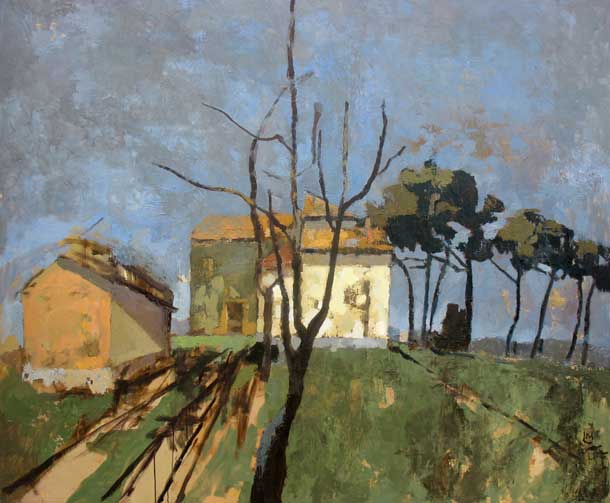
Lucy MacGillis Astoncolle II 50 x60 inches Oil on canvas 2010
click here for a larger view
Lucy MacGillis is a painter who has been living in Italy since her graduation from the University of Pennsylvania in 2000. Her paintings are represented in private and corporate collections internationally. She shows her work at a variety of venues in Europe and the United States including the Galleria Ca’d’Oro in Rome and the Hoadley Gallery in Lenox, MA She now lives and paints on a hilltop near Montecastello di Vibio in Umbria, Italy.
Lucy grew up in the Berkshires in Massachusetts and studied painting at the University of Pennsylvania with John Moore and with Nicolas Carone at the former International School of Art in Italy. Here she also studied with Ruggero Savinio, Jake Berthot, John Lees, Ying Li and Dan Gustin. She received a post-graduate grant to paint in Italy in 2000 and decided to stay. I would like to thank Lucy MacGillis for taking the time to write such thoughtful words to my email questions to her. I am impressed not only by the success of so many brillant paintings but also that despite our down economy she has made a successful career and life for herself doing what she loves, being a painter. Grier Horne’s blog article about Lucy MacGillis quoted her; “I saw a lot of my colleagues going into frustrating teaching jobs and the like, in order to pay the bills and they suffer as artists. You need time to think things through and a lot of time to produce a body of work. I live really simply and try to keep it that way.”
Larry Groff: Can you tell us a little about your background? What made you decide to be a painter?
Lucy MacGillis I’ve been living in Italy for 13 years now. I grew up in the Berkshires in western Massachusetts and studied painting at the University of Pennsylvania and here in Italy at the International School of Art.
I remember going on an elementary school field trip to the Clark Art Institute in Williamstown… there happens to be a Piero della Francesca, Madonna col Bambino e Quattro Angeli there. The museum provided us with robes made exactly like the ones that the Madonna and angels are wearing in the painting, I got to be the white one on the left. This experience enchanted me at the time, and to this day Piero della Francesca is important to me as a painter. I live about an hour from Arezzo where his incredible cycle of frescoes representing the Legend of the Cross is, and I go there frequently. I fell in love with painting while studying at Nick Carone’s International School of Art in Italy and struggling to paint the vast panorama of the Tiber Valley. Even then I loved everything about painting, how difficult is, the smell of it, the names of the colors…rosso pozzuoli! Brilliant Yellow Extra Pale! Davy’s Grey…I was covered in paint.
Being a painter has allowed me to follow the light, the weather, my moods, being inside with a still life when it is windy, outside drawing in a piazza when it is sunny but cold, preparing the surfaces on the darkest days. During the golden hours of the summer, I need to be painting in that light, I don’t want to be doing anything else.

Muri 3 52×52″ oil on canvas 2010
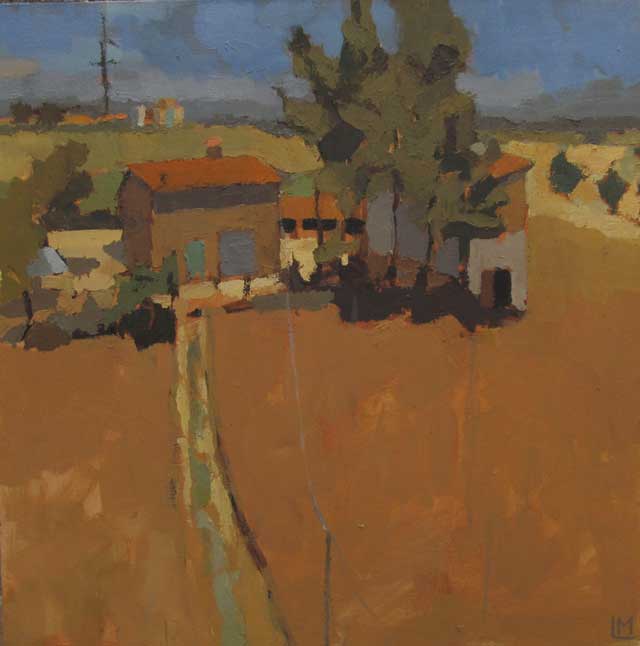
Astoncolle, Mezzogiorno 30″ x 30″ oil on linen 2012
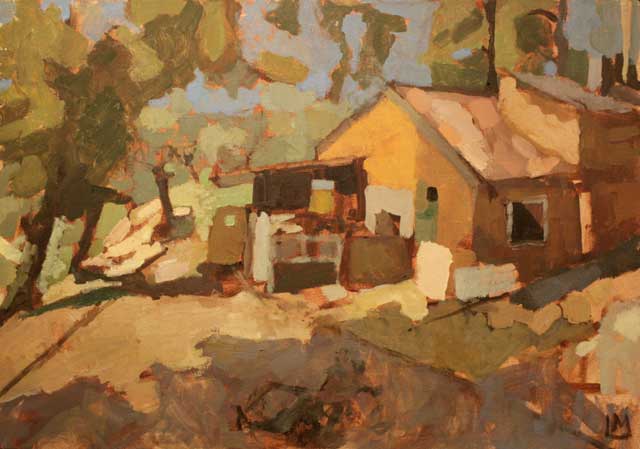
Il Pollaio 16.5″ x 23.5″ oil on muslin panel 2011
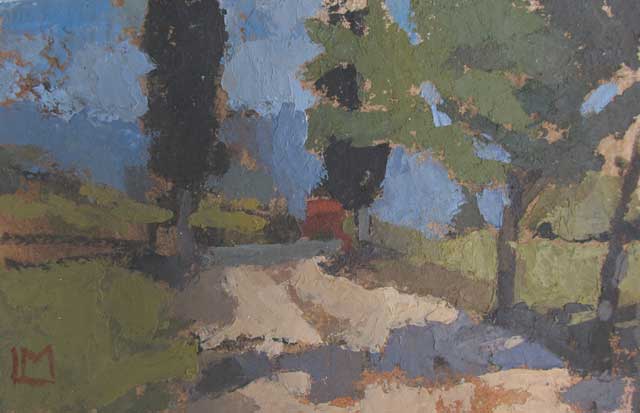
San Romualdo, sole 8.5″ x 13″ oil on primed handmade paper on wood 2012
LG: I’ve read that William Bailey has a studio near where you live in Italy and has played a role in your painting life. You have also studied with the late Nicolas Carone who founded the International School of Art in Italy and is also located in Montecastello. Can you tell us something about how your involvement with them was influential?
LM: At the art school in Montecastello there was an open studio night and Nick Carone came into my little studio followed by an entourage of
teachers. I had painted a small 10×8″ landscape and he went nuts over it “thats it!”. Moments like that pushed me and I painted more and more. Nick’s presence gave an amazing energy to the school. We would sit in the piazza until late at night listening to his stories, stories about painting, his colleagues, life, women…it was important for us to sit and listen, to be humbled by such a great artist.
When I moved to Italy definitively in 2000, I had a ’69 Vespa that I would drive up to his studio on.. he would talk about metaphysics, we would look at the shapes in the clouds and on the stones. I would ride back to town with this rush of adrenaline to work. Looking back now I realize how generous he was, spending so many hours with young artists.
Bill Bailey is a kindred spirit. In a critique in 2000, he looked at a still life of a white enamel pitcher I had painted. I thought it was complete…he said, I know that pitcher, and you need to go back and look at it again, keep looking. He was right. In my work today I still look, I’m still learning to see more.
Both Bill and Nick created these wonderful studios in Umbria, hidden in the hills. Visiting these places I learned a great deal about creating a studio…a sacred place where you can concentrate, walk away from your painting into a field, not be disturbed, where you can become completely absorbed by your work.

Il Vicolo 7.5″ x 10″ oil on paper 2011

La Cinquecento 20″ x 20″ oil on linen 2011

Montecastello 16×16″ oil on linen on wood 2009
LG: You’ve been living near Montecastello di Vibio in Umbria, Italy since you got out of school in 2000. Since then you’ve restored an old farmhouse on a hilltop complete with a fabulous studio. What’s it like to live in paradise? Was it difficult to move from the US to Italy?
LM: I restored an old farmhouse with a small olive grove here in Umbria where I live with my son Vito who is now 6. I live in a place that continually inspires me. I restored it attempting to respect the Umbrian tradition and its humble character. It is surrounded by an original cobblestone piazzetta. These field stones reflect light up at the house. The floors are made of handmade terracotta tiles from Citta della Pieve. Outside there is a wide stone bench which is ideal for lying on and looking up into the almond tree.
I think painters need to be alone, so much of what happens at the easel is related to what you’re dealing with around that. I’m learning to be quite stubborn about my solitude. Even in the moments when I can’t be painting, I see compositions everywhere…the golden hour makes even the industrial zone look glorious. Jody Joseph, a great painter and friend who comes often to this area to paint, marvels at how she nearly drives off the road looking at the compositions that she sees in the rear view mirror driving around this part of umbria. That’s how it is, everywhere you turn, there is a painting.
I painted the interior walls of my home and studio in the traditional style using lime and earth pigments to make paint. Even in the bathroom I look at dark grey walls and their relationship to a white towel, to the stone. By the time I stand before my easel, having taken Vito to school in my ’66 Fiat Cinquecento, gone to the bar for an espresso, bought the newspaper, I’m “carica”, charged, so ready to paint.
I came to Italy after graduating from the University of Pennsylvania, I had received a University Scholars grant to return to Italy… I had a backpack full of paint and planned to return to the States when I’d run out of money. Meanwhile my paintings began to sell back in the U.S., so I stayed. I learned Italian quickly. Aside from my love for Italy, the art, Fellini and the rest, for a self-employed artist it made sense to be in Italy then, here I was covered by the social health system and didn’t need another job to support myself. It wasn’t always easy at the beginning, looking at the series of still life I painted in Todi in 2000, I realize how lonely it was then before I found the friends I have today. Sometimes in the winter a thick fog fills the valley and the landscape is swallowed up for weeks at a time and the dark stone streets of the villages are quite gloomy.
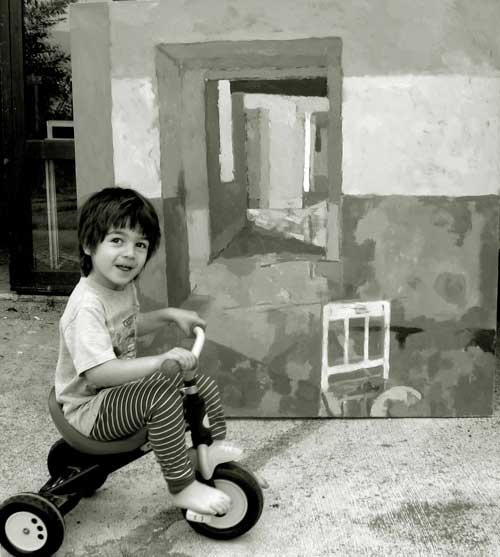
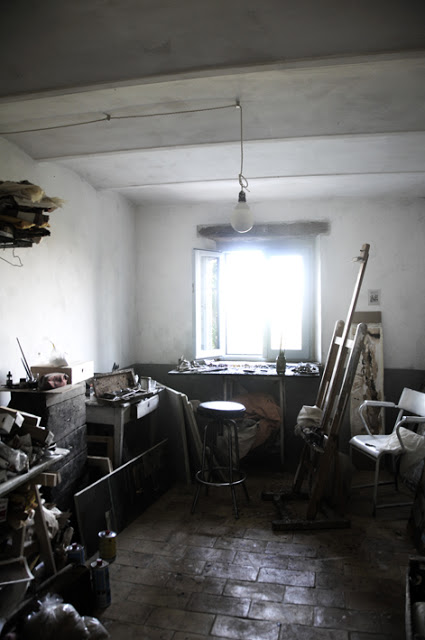
photo by Dee Purdy
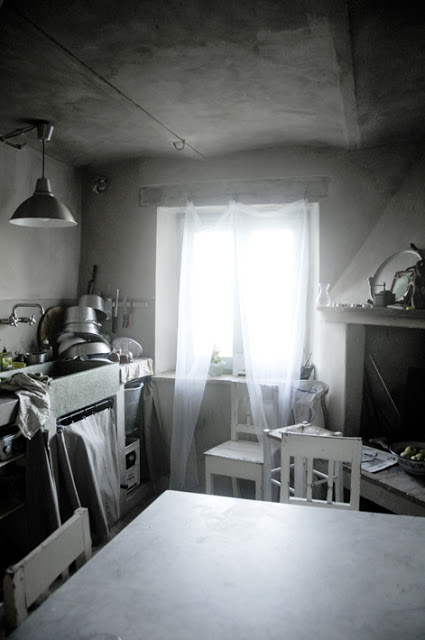
photo by Dee Purdy
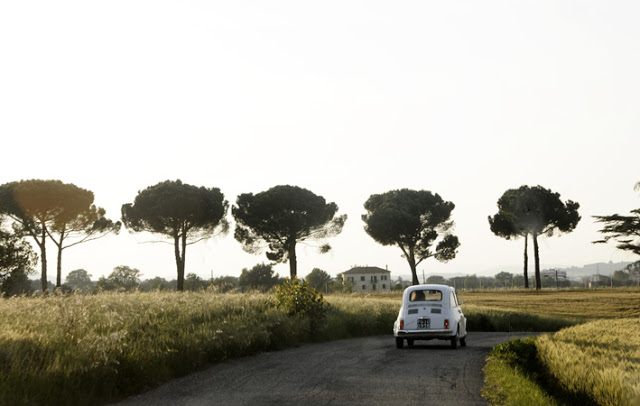
photo by Dee Purdy
see more great photos of Lucy MacGillis’ home and studio from the photographer Dee Purdy’s blog: she had us at hello
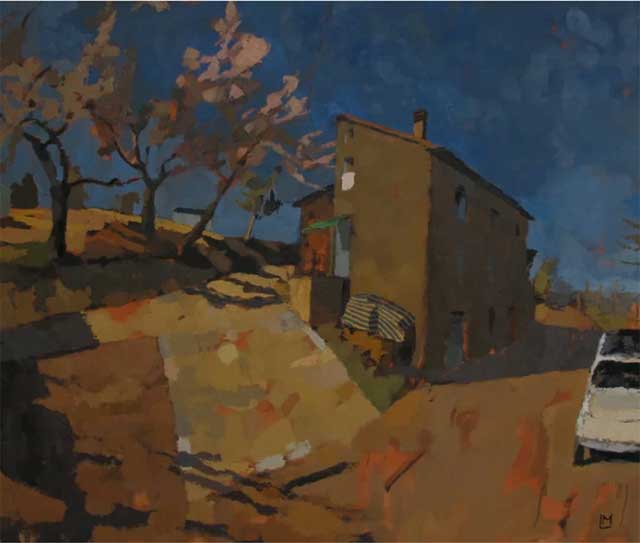
La Primavera 2012 50 x 60″ oil on linen
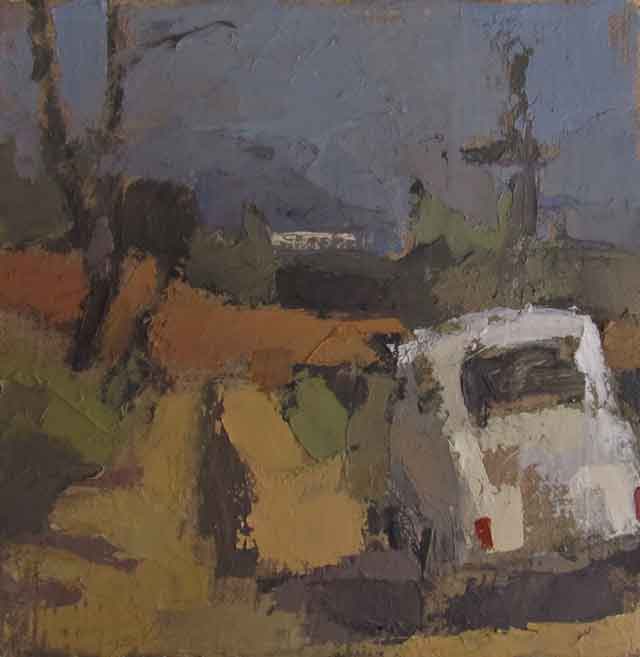
Febbraio 8×8″ oil on linen 2013
LG: How has living in Italy influenced you as a painter? Has being away from NYC artworld helped or hindered your growth as a painter? I see that you are giving a 2 day workshop in Stockbridge Ma at the IS183 school this summer as well as Vienna and Germany. (for more info see this link)
LM: I’m grateful for the distance I have from the New York art world…I’m generally not comfortable around the business of art…Nick talked about the ’50s and ’60s in New York.. it sounded
wonderful then, he said it was the artists who made the artist then, not the galleries and critics.. I figure if I’m doing anything worthwhile, New York will find me. Here I can just draw and paint and get lost in my work.
At the same time there is just so much great art to see in central Italy. A few days ago I was looking at the vibrant frescoes by Benozzo Gozzoli in Montefalco, the Orvieto duomo, the Lorenzettis in Siena, oh it just goes on and on.
Over the past 13 years here in Italy I’ve found a wonderful group of artists, I’m not totally isolated, we look at each other’s work, see shows in Rome and central Europe, but in my daily routine I have the solitude I thrive on. I do enjoy visiting New York when I return to the States each year. I’m in touch with some great artists from that world, such as John Lees and Jake Berthot…when I’m in the city I visit the Betty Cuningham Gallery to see what they’ve been up to. The itch to paint doesn’t really hit me until I drive out of the airport in Rome and see that light.
My life is holistic here. Vito and I go for walks in the olive groves around the house, we make treasure hunts, collect pine cones. I make my own olive oil, eat good food enjoy local wines.
Now I do teach these brief seminars, I love watching people beginning to paint, watching the struggle, discovering painters. I started teaching when some local women asked to me to hold a class. Despite their living a half an hour from the Giottos in Assisi and Piero in Arezzo, they had no art history, no idea, they were blank slates. However having lived all their lives in these hills they have an innate sense of the color, and from the get-go they see and mix these earth colors so much more accurately than many of the New York painters who come through Umbria. This summer I’ll be teaching at the IS183 in Stockbridge, Mass. again, a wonderful old building in a great community of artists. I enjoy returning to the States on brief trips, but I am always longing to return to Italy.
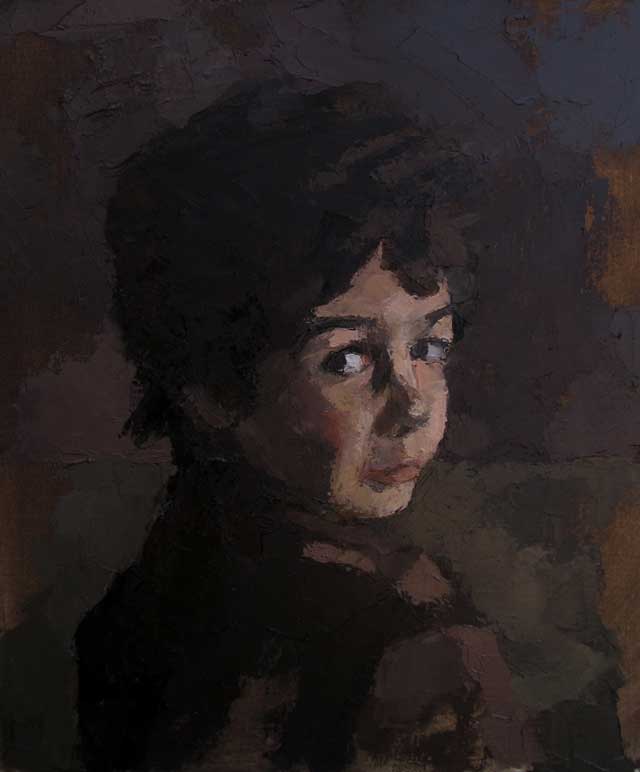
Vito 14″ x 12″ oil on linen 2012

Il Terrazzo 30″ x 30″ oil on canvas 2011

Due Case 8.5″ x 11″ oil on primed paper on wood 2012
LG: I’m curious if you were able to see the Giorgio Morandi’s Landscapes exhibition “Morandi, l’essenza del paesaggio” at the Fondazione Ferrero in Alba, Italy in 2011? I’m curious to hear what you might have to say about his painting in relation to your own work.
LM: I first saw Morandi’s work on a trip to Bologna in 1999, the museum has this magical quality. It must be one of the quietest public places in Italy. The show in Alba included some landscapes that I hadn’t seen before. There was one from 1942 that I just fell in love with. Morandi was quoted saying that he loved painting the landscapes more than the still life, you can see that in these nearly abstract landscapes from around 1941 with these flat skies that look like lakes on a map. So simple, then you stand out there with your easel and try to simplify all that green and you realize how complex his paintings really are. Nick talked about meeting Morandi at the Venice Biennale,and his reaction to Pollock. What I so admire about Morandi is what he didn’t paint. He just kept on painting what he saw amidst all that political and artistic turmoil.
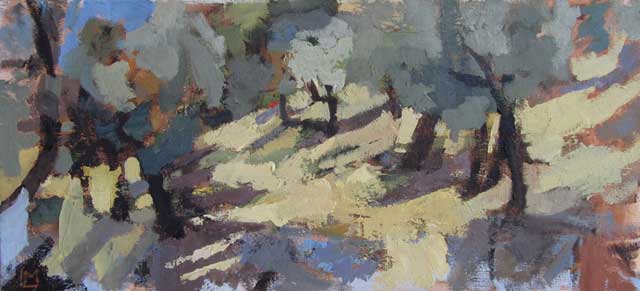
Gli Ulivi 8″ x 20″ oil on linen 2012
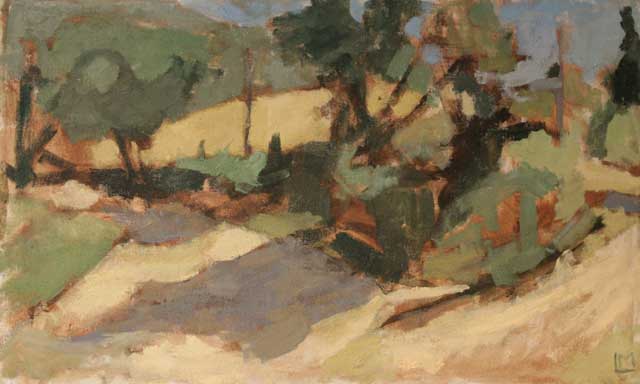
Via Fornaci 12″ x 20″ oil on linen panel 2012
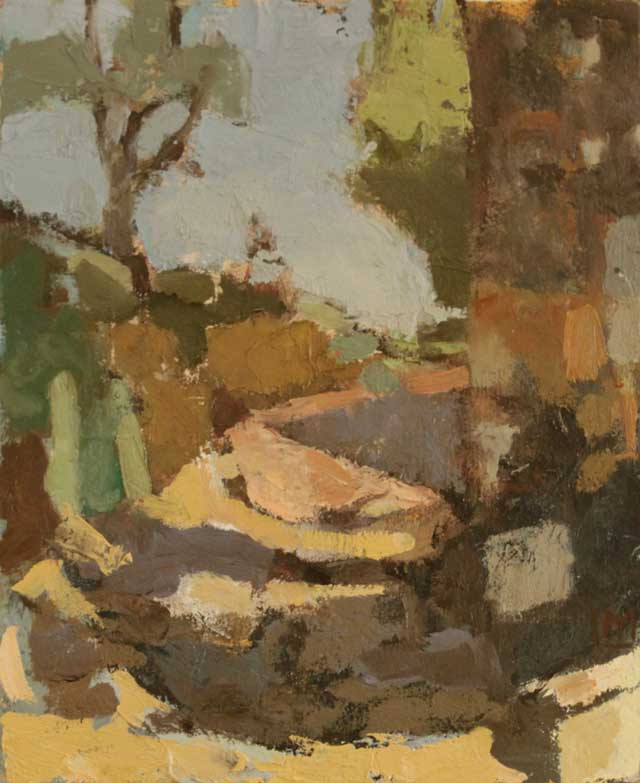
La Mattina 8″ x 7.5″ oil on muslin panel 2010
LG: How important is observation to your work?
LM: I always paint from life. In the landscape I remove and add where it works best for the painting, but I’m out there. The experience of being physically in the landscape I’m painting is important, the heat, the smells, the sounds of the nearby sheep, the train’s distant horn, the light. I’m convinced that it all plays into the feel of the painting and I react to all this. There is so much to see and the longer you look the more you find. I look for shapes, I forget what object I’m painting, just look and mix and put paint down. Both Jake and John Lees have left New York for the country, they observe the
woods and streams near their studios. There is something to be said for becoming so familiar with the rhythm of your surroundings…I look out at the panorama from my studio and am so profoundly in tune to the small seasonal shifts.
Lately I’ve also been working a good deal from the figure. I love listening to models while I observe them… how the planes of the face shift as a person poses, as they grow more relaxed, as the music changes. I listen to good music while I paint inside, lots of jazz, Nina Simone, Carlos Gardel, Vinicio Caposella, Maria Callas, depends on the day.
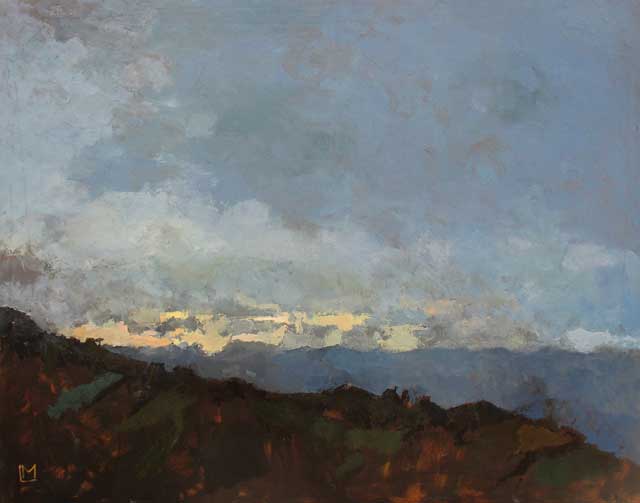
Terra Umbra 38×48″ oil on canvas 2009
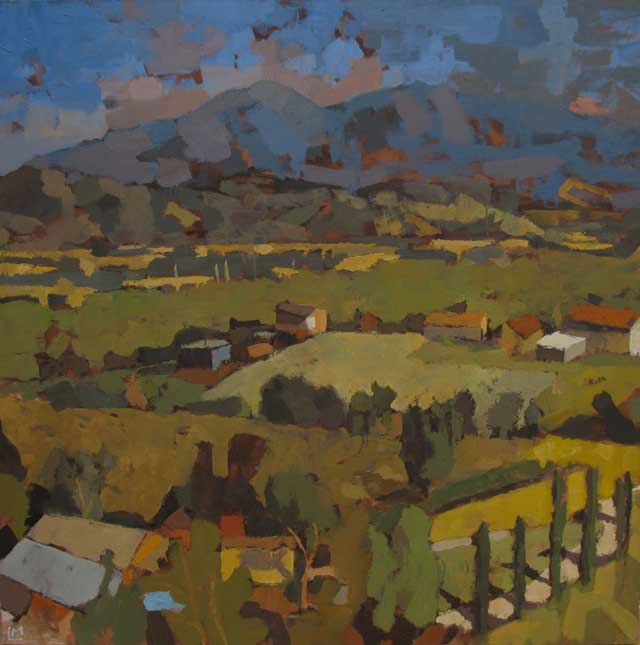
San Gaspare 52″ x 52″ oil on linen 2012
LG: Can you speak about your painting process. Do you limit your palette? I’ve read where you have used the Italian Earth colors such as what Williamsburg makes. What makes these types of paint valuable to you? What else might be of interest about your technique or approach to painting?
LM: When I teach I limit the palette to a basic earth palette. I do use some Williamsburg paint but here in Italy I have access to Maimeri’s Terre Grezze which have a great Rosso di Ercolano, Rosso di Venezia and Terre Verde Antica di Verona. These paints have a good thick consistency and I love using the palette knife with them. When I’m working in my studio I use a lot of paint I make on my own and I do use some cadmium orange and red. In Florence I find beautiful pigments at Zecchi and grind these with cold pressed linseed oil to make my own thick paint. I also use some marble dust from Carrara. I stretch my own surfaces and prepare the linen with rabbit skin glue. The process is all part of it, touching these materials, using my physical strength to stretch the linen tight, reflecting on what I will paint on this dimension, watching the surface tighten, sanding it down, I become familiar with it, I prepare the composition in my mind.
I draw everyday, on whatever I can find. I’m delighted that my son has the same habit, although he usually draws ships. As I begin to paint I plot out the composition with the brush, play with it, remove it, again and again until it works. Jake Berthot helped me a great deal with this part of the painting, being patient with it, finding rhythm, duality, pushing it as far as I could.
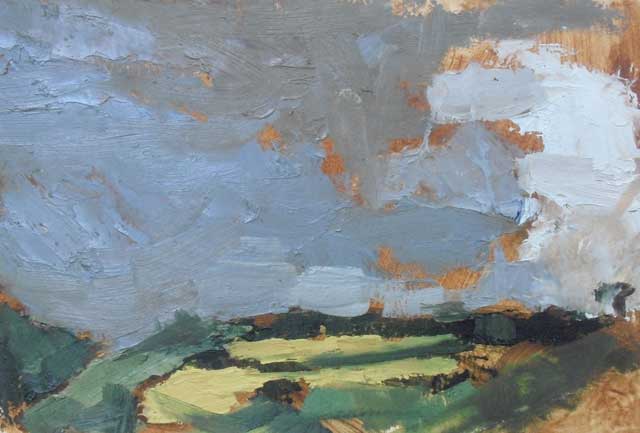
La Tempesta 8.5″ x 11″ oil on paper on wood 2011

Arrivederci e Grazie 20″ x 19″ oil on linen 2011
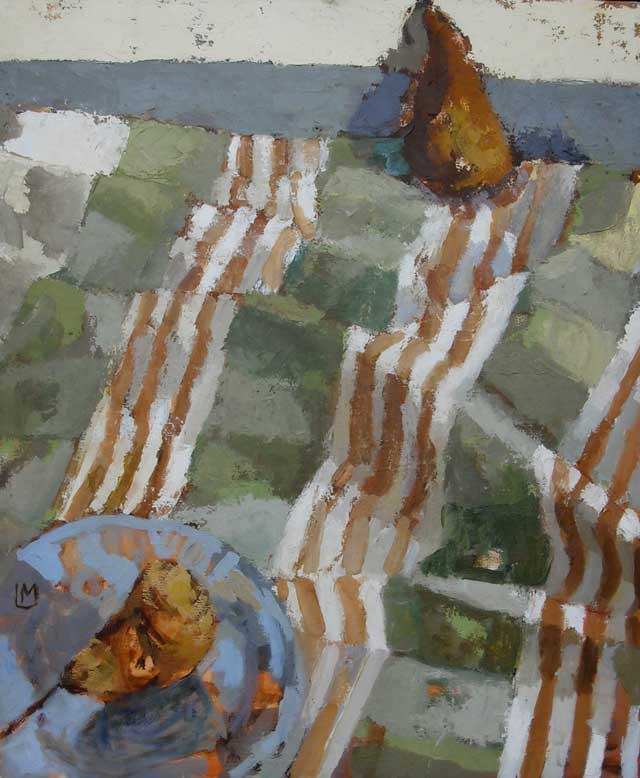
L’Inno Nazionale II 24″ x 20″ oil on canvas 2011
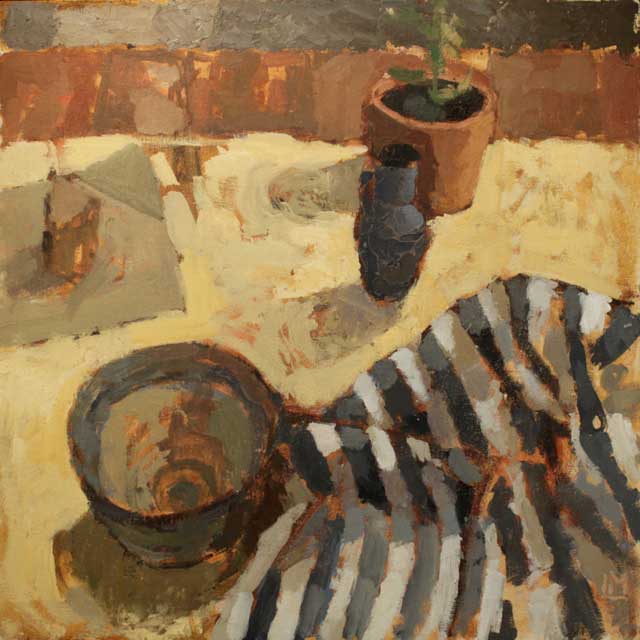
Natura Morta al’Aperto 20″ x 20″ oil on muslin panel 2011
LG: Your broad, expressive paint handling tells us that you’re interested more in engaging the paint surface and creating abstract structures than mere description. In particular, your color harmonies very satisfying. Do you arrive at these color decisions quickly? Would you say you’re a slow or fast painter?
LM: Well I suppose I ought to be a fast painter, when I’m slow I lose it.
I like to simplify what I see, push it into abstraction. I make marks with the palette knife or a large flat brush. I scrape down a lot, mix strange greys, mixing compliments. I look for the darkest and lightest points in the painting and try to keep the color in key with them. Catherine Kehoe lays down these bold planes, her portraits rock. I’m always trying to paint looser, to let the paint be, to let go sooner. I work on some paintings for months, others just happen in a couple of sittings. I enjoy the faster paintings most..see I’m painting this very sort of picturesque landscape here, I don’t want to make pretty paintings, so I’m looking at planes and color and trying not too get too hung up with insignificant details.
Have you looked at Ruggero Savinio’s paintings? His figures have this wonderful presence, he observes them but somehow gets at the soul rather than physical likeness. He knows the figures in his paintings, they are his family, you sense that. I learn a lot from looking at his work.
LG: What’s the most exciting part of painting for you?
LM: There is the point where I become so immersed in painting, total self-abandonment. Where I’m in this sort of hypnosis of looking, mixing, looking and laying down marks. I was recently working on a portrait and the model asked if he could photograph me because I make such a “strana espressione” strange facial expression while I paint. Of course that killed the moment but I guess I was really in it then.
LG: How do you know when the painting is finished? How important is keeping the painting “fresh”?
LM: There is a point when I physically cannot do anything more to the painting. It is done. At that point its probably overdone, I should walk away from them sooner, at a medium-rare moment, when the marks are sufficient. I’m trying to preserve the transparency, let the ground show, or if I’m painting over old paintings which I absolutely love doing, have parts of the previous one peek through.

Limoni Amalfitani 20×19″ oil on canvas 2010
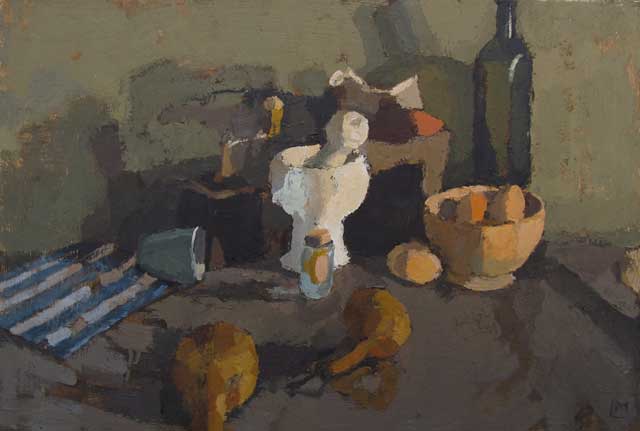
Il Salaiolo 18″ x 27″ oil on linen 2012
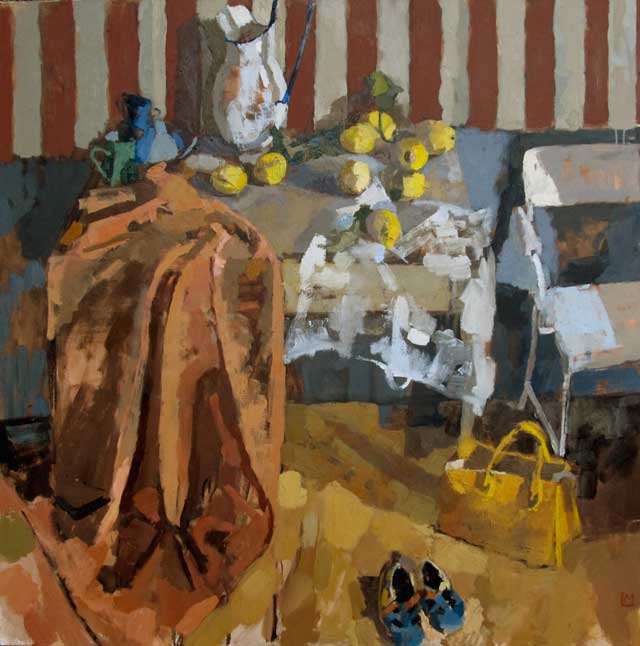
Sandali di Vito 52″ x 52″ oil on linen 2012
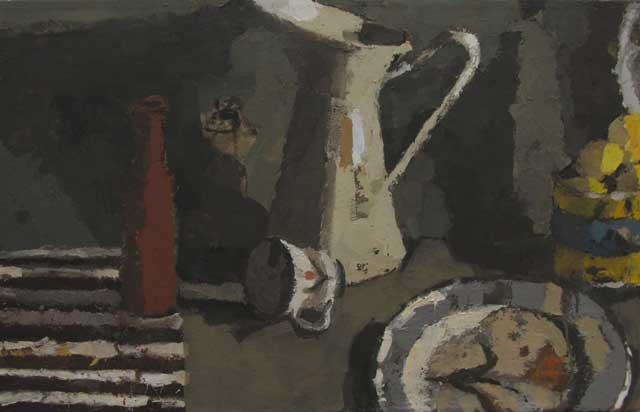
Sant’Ubaldo 20″ x 32″ oil on linen
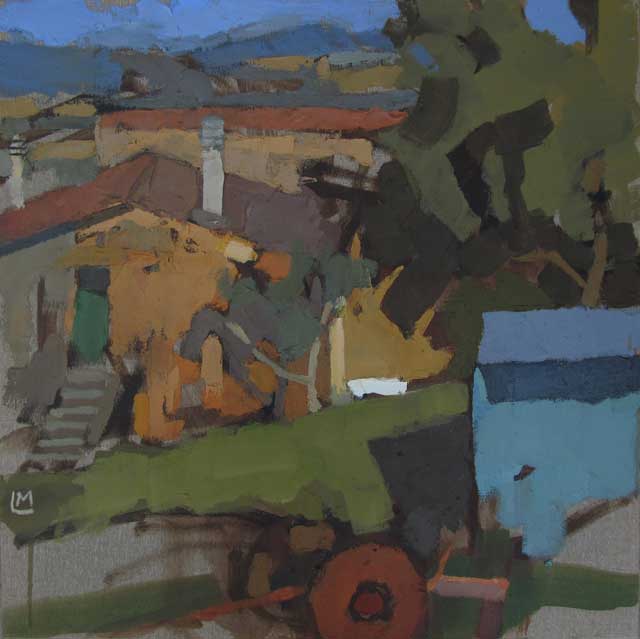
L’estate 20×20″ oil on linen on wood 2012


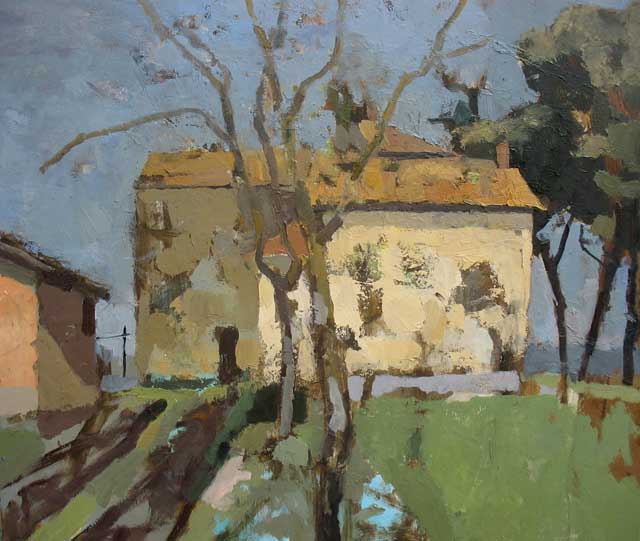




Absolutely captivating palette and paint handling, homage to Mornadi with a fresh vision. Congratulations in order.
Lucy’s work takes my breath away. Restful to look at and exciting at the same time.
Larry,
How do we thank you for doing these great interviews and introducing us to so many artists and their interesting work?
I’m very impressed with Lucy’s work.
Valerie Cordaro
Once more a wonderful interview of with a painter who is doing some compelling, thoughtful work.
Thank you for turing me on to Lucy’s work and a snapshot of her remarkable life.
The work is really beautiful and I really wish I could see them in person some day.
Interesting that she knows John Lees. I had the privilege to have him as a visiting artist many years ago
at the Museum School in Boston. Wonderful man and painter.
One question that crossed my mind. Italy is in the midst of a very serious economic downturn.
One could say it’s the worst since the late 40’s (after WW2) and early 50’s.
I know if I was living there this would be something that would be of concern.
Jeff
Thank you for sharing this interview with us. I love Lucy’s work.
Dear Lucy
Many thanks for so many lovely expressive pictures – but also a very valuable interview ….much of
which might be part of “explaining” what, how and why you paint as you do….for us struggling hobby painters. Whats important and what isnt (ie “pretty pictures”)…. before we strt up in your courses.
Love and hugs to you and Vito.
Cant wait to be with you soon again
Ivar.
Marvelous interview and beautiful work! I wasn’t surprised to hear that Lucy and Jody Joseph are pals. Jody is a hugely influential painter and teacher in my neighborhood, west of Toronto. It’s interesting to see how a certain sensibility about painting is being passed forward from Nicolas Carone, Jake Berthot and, in Jody’s case, Wayne Thiebaud. Thanks to Lucy, Larry and Jody for sharing so much of what you know and love about this mysterious and enduring activity.
Many thanks to all of you. Jeff, “la crisi” here in Italy is quite serious, you’re right…with gasoline at about $9.00 to the gallon lifestyles change. I’m concerned about my colleagues here, it has become almost impossible for them to support themselves with their art. Locally factories are closing left and right. However I am also aware that this generation of 30-something Italians has (until now) turned its back on the resourcefulness of the predecessors. The stereotypical local guy drives an Audi paid for with his grandfather’s pension, while the grandfather works hard in the olive grove to make the olive oil for the family. There are some exceptions but very few local young people are interested in the agricultural tradition which is so fundamental to Umbria. At a time like this when they are losing their jobs, I can only hope that this will have the positive effect of literally bringing this generation back to its roots. – L.
Even for a non-artist, this interview and the paintings were enlightening and inspiring.
Amazing!Is there any way to come and paint together with this painter for a weeks holiday.Not tuition but just as a contact to see and get to know that area?
Thanks